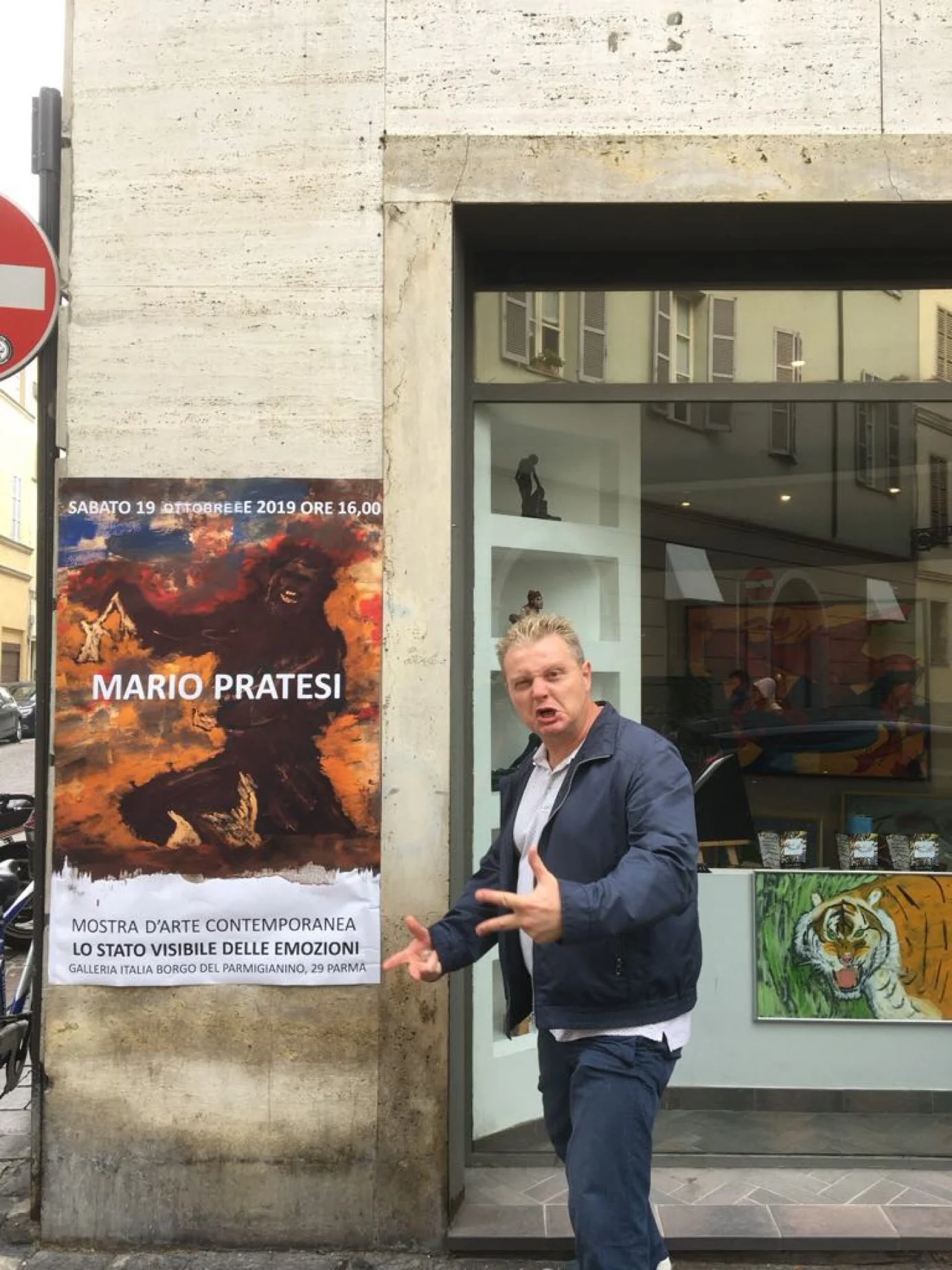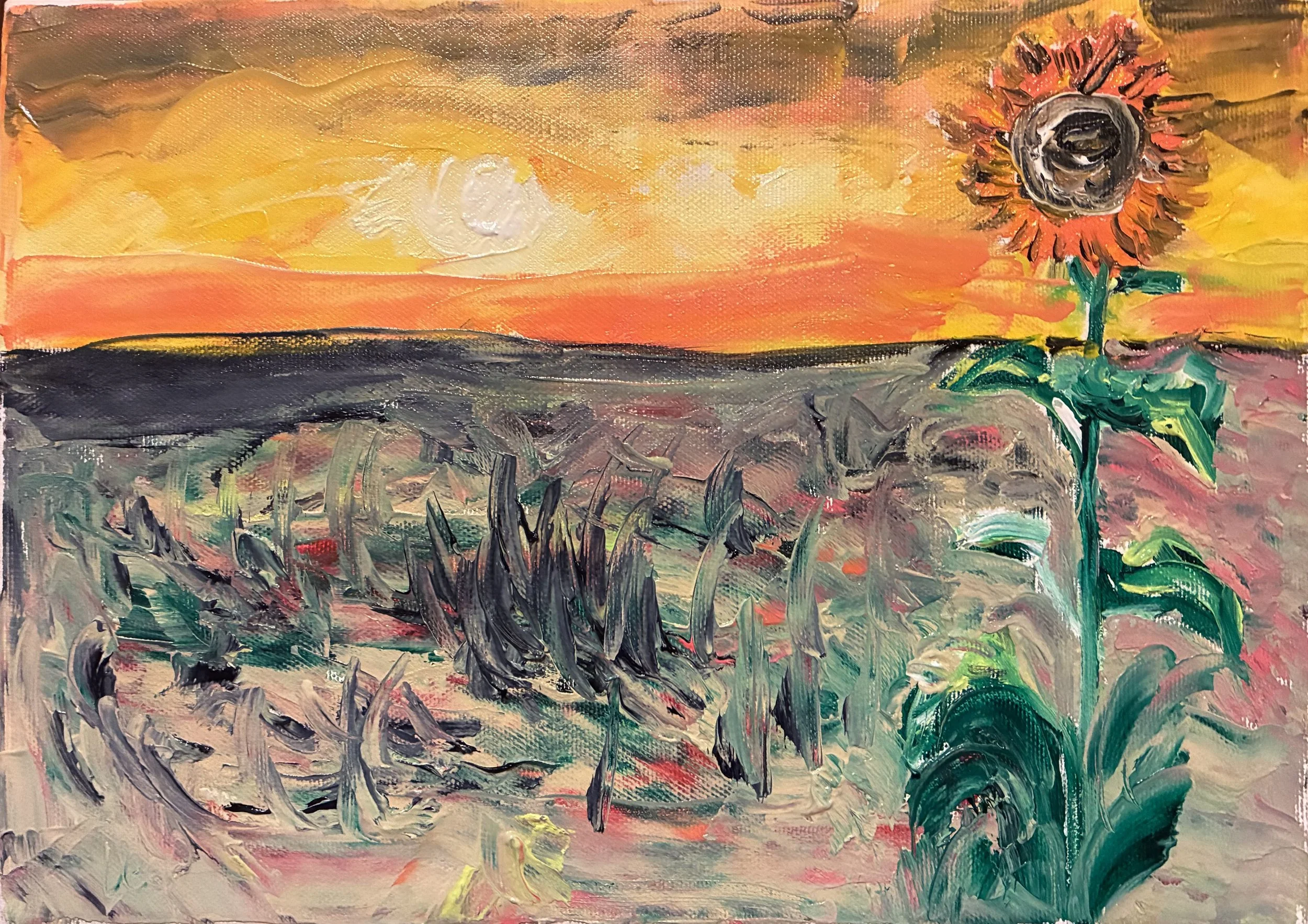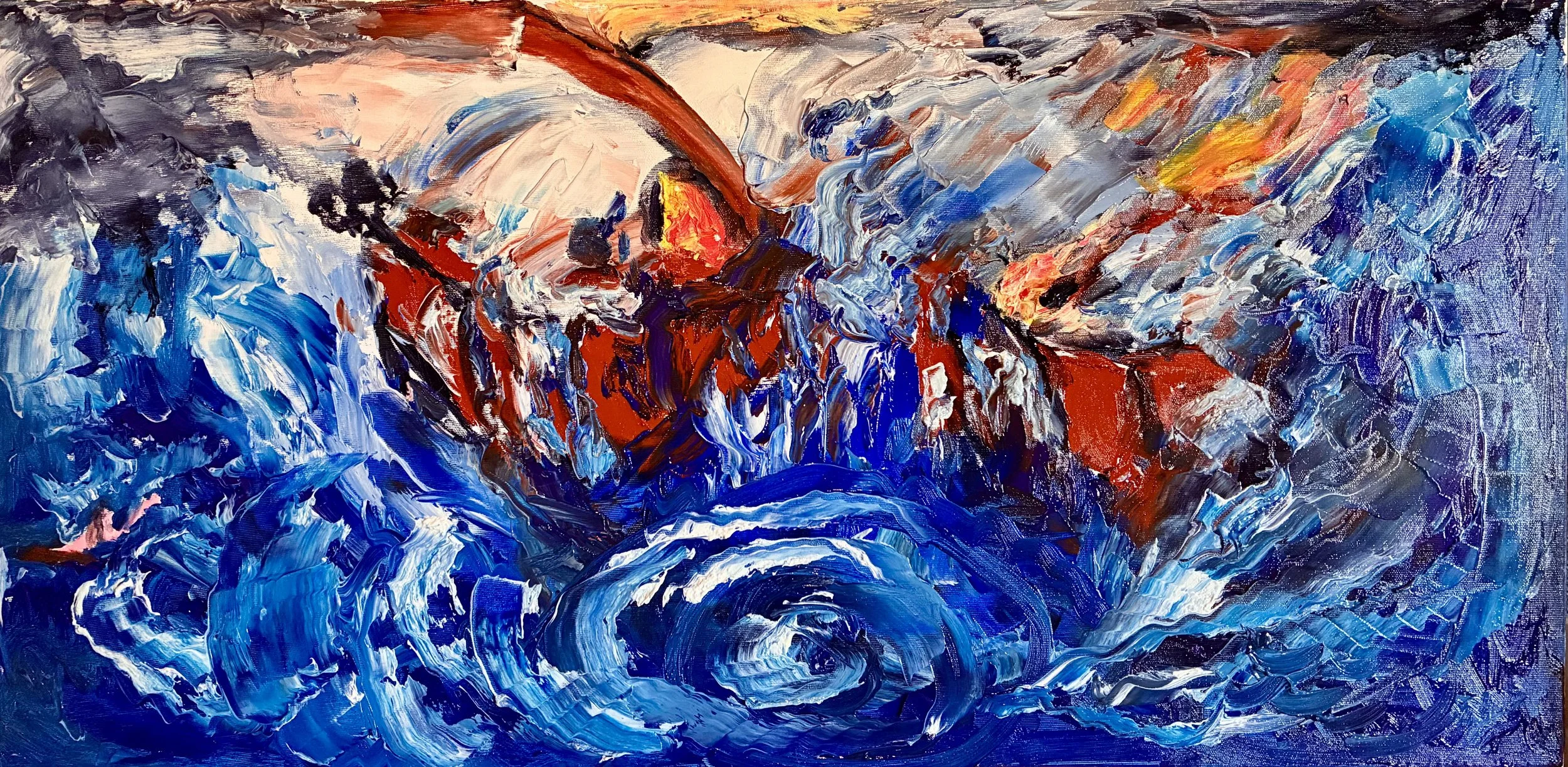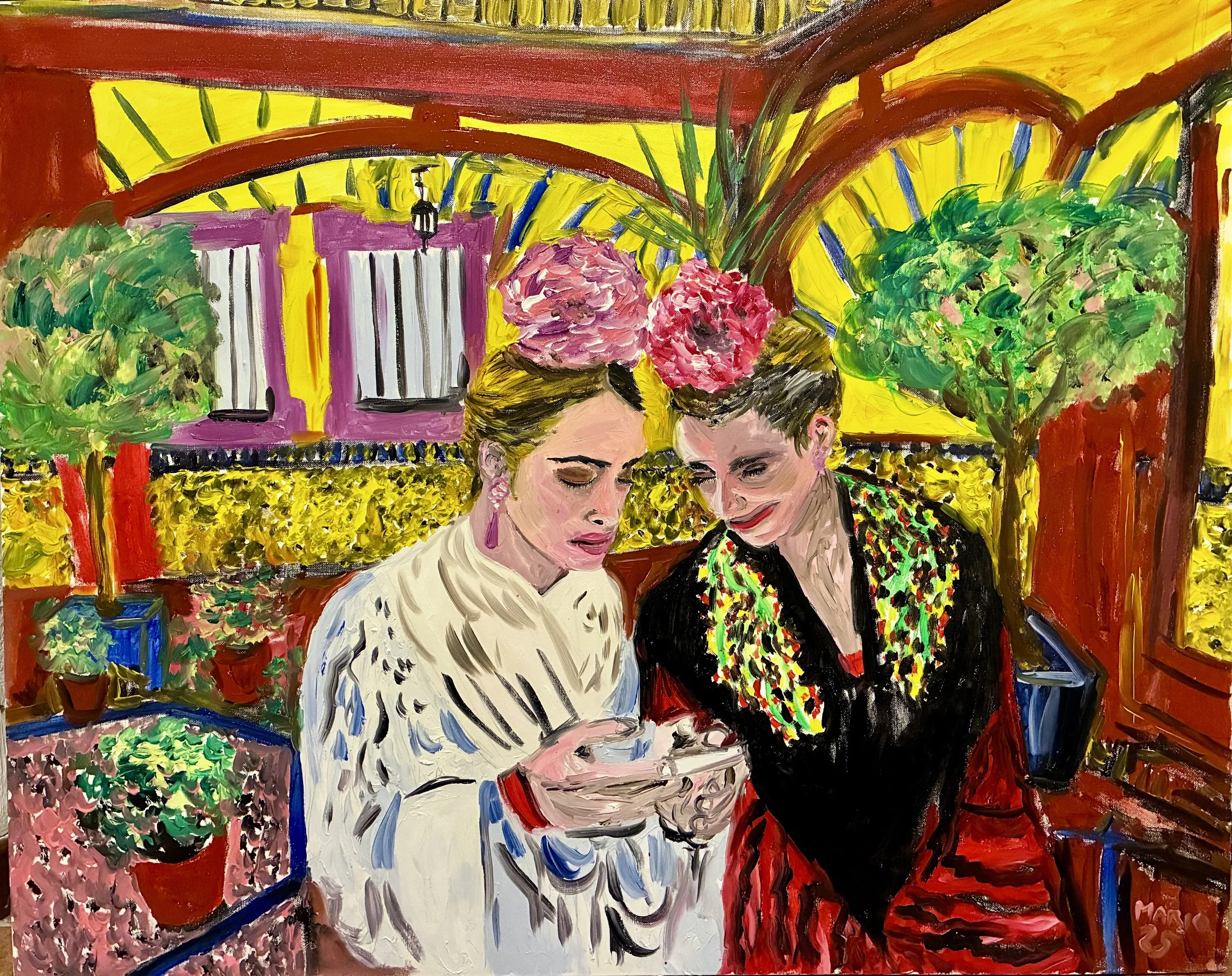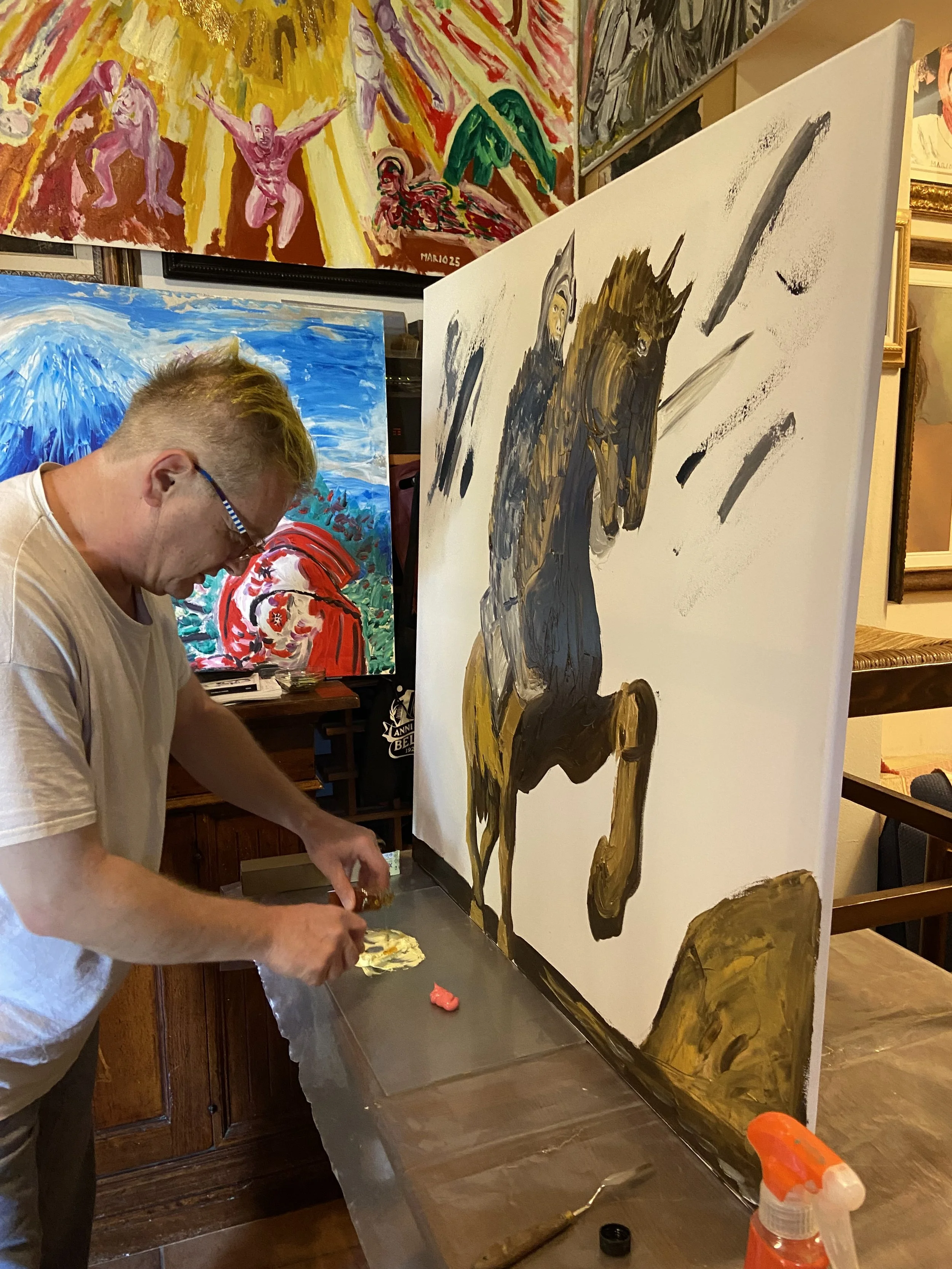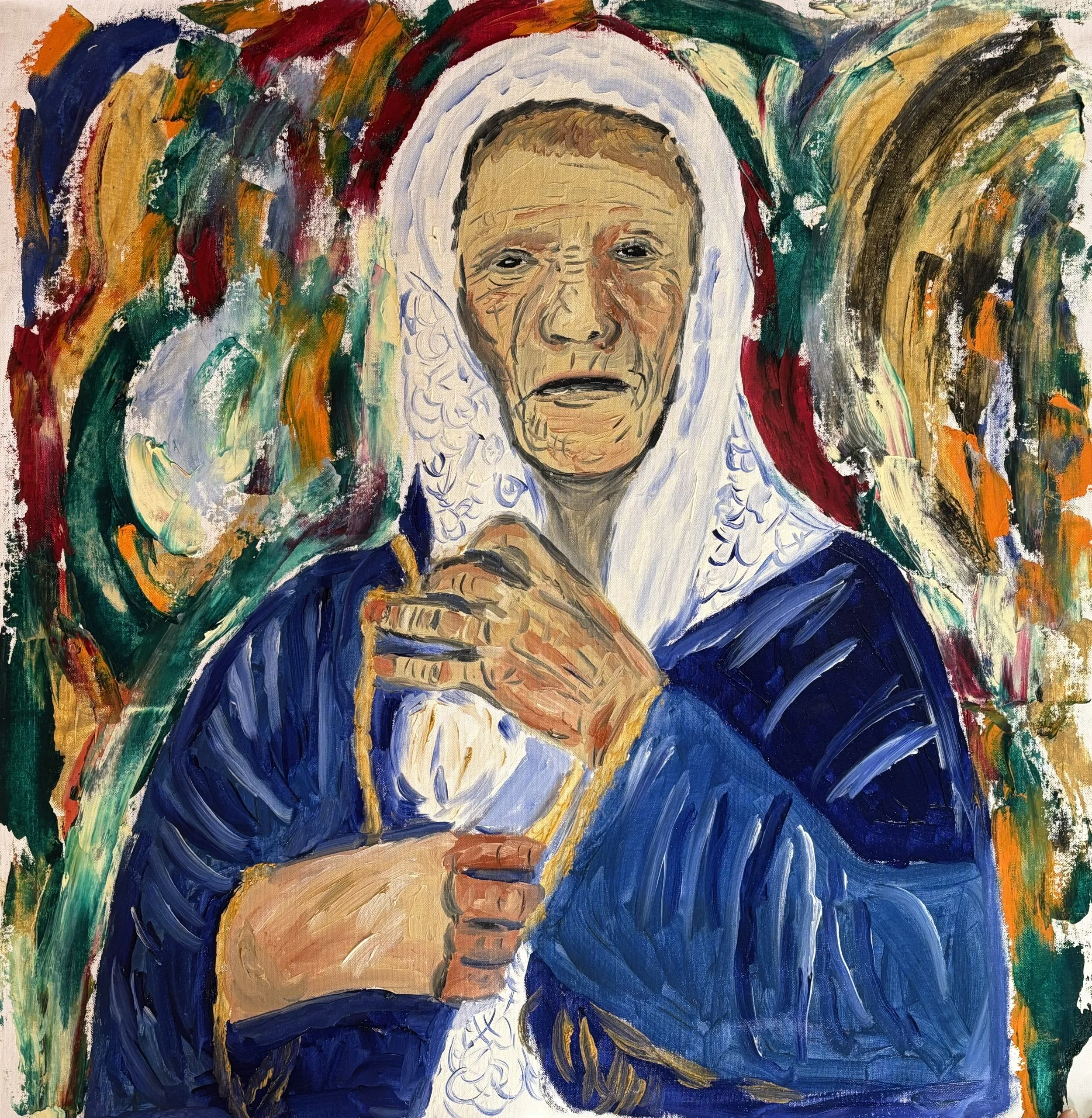Mario Pratesi
Mario Pratesi Born in Florence in 1972, he lives between Siena and the province of Florence, where he still lives. He traveled with his parents as a child, a fact that contributed to his education and open-mindedness, and which allowed him to explore ancient art, history, and monuments from an early age. He currently lives with his partner Angiola and works in a bank.
Pratesi's art has been compared to Fauvism due to its intense color, although he is keen to emphasize that his creations are the result of a highly personal creative process. To date, he has created over 1,070 works, mostly in oil on canvas and cardboard. Pratesi's artistic output is characterized by its eclecticism and the diversification of the themes and topics he addresses. This breadth of subject matter, ranging from prehistory to the space age to metaphysics and history, is the result of a lifelong thirst for knowledge, inherited from his parents, who were insatiable readers. He has exhibited in various Italian cities, including Rome, Venice, Florence, Milan, Parma, Siena, Pienza, Bologna, and even Barcelona. He collaborates regularly with galleries in London, magazines, and websites in France, Spain, Sweden, and Italy.
Mario, your artwork demonstrates an expressive intensity reminiscent of Fauvism and Expressionism, yet with a deeply personal twist. How do you find a balance between being influenced by historical art movements and ensuring your work reflects your unique artistic voice?
Well, actually, my art has often been associated with styles born at the beginning of the 20th century. In reality, when I paint, I don't think of a particular "style," I just do it. I focus more on emotion and achieving the result rather than on the style and the means to achieve it. Perhaps this stems from being self-taught and not trained in any academy, thus free to express a completely personal style, which, perhaps by chance, crosses paths with Expressionism and the Fauvist movement.
Many of your paintings seem to arise spontaneously, created in moments of sudden inspiration, whereas others appear carefully thought-out. Could you elaborate on how you navigate these two contrasting creative processes and what factors determine the approach you choose for each artwork?
The point was hit perfectly, because I often work without a plan, "on the spur of the moment," and other times I begin planning the painting days before painting. It's not easy to understand why this happens, but I think it depends on the emotion of the moment and the need I sometimes feel to vent through painting. It's as if I feel the need to relieve pressure from my head, even though, thanks to the colors and themes I often deal with, I almost never produce sad or heavy works. In any case, whether I start on impulse (perhaps by watching a film, a documentary, or listening to music) or I begin the work with a plan, the ultimate goal is always the exploration of ever-new themes, within the context of beauty.
Given your background as a video maker before fully embracing painting in 2018, how does your experience in video-making influence your compositional techniques, narrative elements, and sense of movement in your current paintings and sculptures?
In fact, my experience as a video maker laid the foundation for my painting, especially photography. I have almost always conceived my paintings as moving works, expressing a vibration, partly borrowed from cinematic narration (from the Greek kimema = movement) and partly inherent in my vision of the world linked to the perpetual becoming of matter. I abandoned my cinematic career after 3 feature films and 8 shorts, to have greater control over the creation of my works, something not always possible in zero-budget contexts like those in which we have always operated.
Your paintings often explore diverse themes, ranging from historical and mythical characters to imaginative interpretations of contemporary life. How does your fascination with comic books and classical studies converge within your creative process, and in what ways do these influences manifest distinctly in your work?
The human race originated some 30,000 years ago or more and, through metaphysics and science fiction, has come to conceive of realities that surpass our conception of reality.
In between, things have been conceived and events of all kinds have occurred, so I believe that reducing art to the mere repetition of the same subject is very little. When I think of a work, I try to draw from every aspect of my knowledge and culture, and from everything I feel like representing at that moment, without any restraints or obligations.
Considering your extensive travels from a young age, to what extent has exposure to diverse cultures impacted your approach to color, symbolism, and subject matter selection in your expressive style?
I consider myself lucky. I spent my youth in the 1990s, the post-Berlin Wall era, a time of intense freedom that produced some of the best cinema in history. This, combined with trips with friends, nights out, and museum visits without fully grasping their meaning, helped open my mind, making me understand that there is more beyond the ordinary that deserves to be discovered, savored. Now when we travel, I have the feeling of having seen things before; globalization has, unfortunately, stripped cities of their soul, creating new realities, like empty boxes whose only ancient aspect is their exoskeleton.
Your recent exploration into sculpture, specifically bas-reliefs, signifies an expansion of your artistic vocabulary. Could you discuss how transitioning into three-dimensional art has challenged or enhanced your perceptions of spatiality, narrative, and emotional expression in comparison to your paintings?
I have been working on the Ascension of Christ since late 2024, from designing the support to creating the sculpture with modeling clay, to gilding and final painting. This important project was born within me because I believe there is an afterlife; the world is too complex for there to be no guiding principle. I have approached sculpture with mixed success, but with the same creative desire for exploration that I put into my canvases. Indeed, modeling the anatomies with my fingers and spatulas has allowed me to immerse myself more deeply in the works, almost becoming part of them. Each individual piece of the bas-reliefs has been interpreted and conceived with a mix of instinct and reason.
The bold use of color in your works evokes strong emotional responses, frequently juxtaposing vivid contrasts to convey deeper meanings. Can you describe your philosophy behind color selection and how the emotional resonance of color guides the viewer’s experience of your art?
The world around us is full of color. Imagine how sad it would be if we lived in a black and white world. All I do is use pure colors to paint subjects that appeal to me at a given moment, and try to combine colors tastefully. In reality, there is no particular color plan, but rather an attempt—sometimes successful, sometimes less so—to enhance the tones and vibrations the work must express with the purity and intensity of the chromatic palette. Even in works where the use of color is less exaggerated, I still try to compensate with a multi-layered approach to the work.
Some of your paintings depict imaginative reinterpretations of iconic historical moments or figures. How do you approach the task of recontextualizing familiar narratives through an expressive lens, and what role does historical authenticity versus artistic interpretation play in your practice?
I believe that in history, more than authenticity, we should be talking about narrative; more than real images, we should be talking about symbolic representation. When addressing well-established themes, it's a good rule to always use a lens of doubt, given that none of us were present at certain moments and that history is written by the victors. I find the Etruscan urns, which highlighted the flaws, much more realistic than the statues of emperors, whose heads were sometimes even changed. In any case, I love addressing historical themes and representations, but always without taking myself entirely seriously, given that these are works without the need to appear celebratory at all costs.
As someone who maintains a professional life outside the art world, how do your daily interactions, particularly in your banking career, inform or perhaps contrast with your artistic expressions? Has working in a distinctly non-artistic environment enhanced your creativity in unexpected ways?
The bank provides me with a living and allows me to showcase my art.
Since they're very different realities, they don't mesh well, even though I manage to produce art consistently. Art is often a mental escape and an outlet from everyday reality, which isn't always pleasant. I believe an artist should be able to work in peace, to gather ideas and have all the energy available for creation, but I'd have to be rich...
Your artworks occasionally reference universal themes such as existence, spirituality, and humanity's place within broader cosmological narratives. Could you elaborate on how personal experiences and reflections on contemporary society inform your exploration of these expansive themes within your art?
believe today's society is sick but prosperous. We have lost the ability to produce works and amaze ourselves and others with our creativity. Engrossed in our phones, we no longer see the beauty that still exists. Most people refuse to study history and rely on clichés or, as they say today, cognitive biases. The population explosion and resulting emigration will expose societies (and in part already does) to stress, which sometimes leads to war. In my opinion, all these themes are almost obligatory for an artist, who has the freedom to address them as he wishes, as long as he doesn't take refuge in TV-series-style mannerisms. In any case, life is a journey that must be faced with courage and determination, but above all, with awareness.


